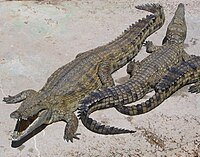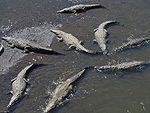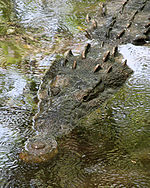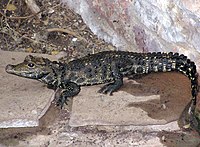| Crocodiles Fossil range: Late Cretaceous - Recent | ||||||||||||
|---|---|---|---|---|---|---|---|---|---|---|---|---|
 | ||||||||||||
| Scientific classification | ||||||||||||
| ||||||||||||
| Genera | ||||||||||||
| See full taxonomy. |
Saturday, July 7, 2007
Crocodile in short...
Crocodile part II.
Biology and behaviour
Crocodiles are ambush hunters, waiting for fish or land animals to come close, then rushing out to attack. As cold-blooded predators, they can survive long periods without food, and rarely need to actively go hunting. The crocodile's bite strength is up to 3,000 pounds per square inch, comparing to just 100 psi for a labrador retriever, 350 psi for a large shark, or 800 psi for a hyena. Despite their slow appearance, crocodiles are top predators in their environment, and various species have been observed attacking and killing sharks.[6] A famous exception is the Egyptian Plover which is said to enjoy a symbiotic relationship with the crocodile. According to unauthenticated reports, the plover feeds on parasites that infest the crocodile's mouth and the reptile will open its jaws and allow the bird to enter to clean out the mouth.

Crocodiles eat fish, birds, mammals and occasionally smaller crocodiles. Wild crocodiles are protected in many parts of the world, but they also are farmed commercially. Their hide is tanned and used to make leather goods such as shoes and handbags, whilst crocodile meat is also considered a delicacy in many parts of the world. The most commonly farmed species are the Saltwater and Nile crocodiles, while a hybrid of the Saltwater and the rare Siamese Crocodile is also bred in Asian farms. Farming has resulted in an increase in the Saltwater Crocodile population in Australia, as eggs are usually harvested from the wild, so landowners have an incentive to conserve crocodile habitat. Crocodiles are more closely related to birds and dinosaurs than to most animals classified as reptiles, the three being included in the group Archosauria ('ruling reptiles'). See Crocodilia for more information.
Danger to humans
- Main article: Crocodile attacks
The larger species of crocodiles can be very dangerous to humans. The Saltwater and Nile Crocodiles are the most dangerous, killing hundreds of people each year in parts of South-East Asia and Africa. Mugger crocodiles and possibly the endangered Black Caiman, are also very dangerous to humans. American alligators are less aggressive and rarely assault humans without provocation. The most deaths in a single crocodile attack incident may have occurred during the Battle of Ramree Island, on February 19, 1945, in what is now Myanmar. Nine hundred soldiers of an Imperial Japanese Army unit, in an attempt to retreat from the Royal Navy and rejoin a larger battalion of the Japanese infantry, crossed through ten miles of mangrove swamps which contained Saltwater Crocodiles. Twenty Japanese soldiers were captured alive by the British, and almost five hundred are known to have escaped Ramree. Many of the remainder may have been eaten by the crocodiles, although gunfire from the British troops was undoubtedly a contributory factor. Crocodiles are the leading cause of animal related deaths as of 2001.
Crocodile blood
Crocodile leather
Crocodile leather can be made into a variety of goods, such as wallets, briefcases, purses, belts and hats.
Crocodile as food
Crocodile is consumed in some countries such as Australia, Ethiopia, Thailand, South Africa and also Cuba (in pickled form). It can also be found in specialty restaurants in some parts of the United States. The meat is white and its nutritional composition compares favourably with that of more traditional meats. It does tend to have a slightly higher cholesterol level than other meats. Crocodile meat has a delicate flavour and its taste can be complemented by the use of marinades. Choice cuts of meat include backstrap and tail fillet.
Differentiation from alligators
While often confused with each other, alligators and crocodiles belong to two quite separate taxonomic families, and are as distinct from one another as humans are from gorillas. As for appearance, one generally reliable rule is that alligators have U-shaped heads, while crocodiles are V-shaped - which can be remembered by noting that "A" in alligator comes before "C" in crocodile, and "U" comes before "V".
Trivia
This article contains a trivia section.
The article could be improved by integrating relevant items into the main text and removing inappropriate items.
- The crocodile gets its name from the Greeks who observed them in the Nile river. The Greeks called them krokodilos, a compound word from kroke, which means "pebbles" and drilos, which means "worm". To the Greeks, this "worm of the stones" was so named because of the crocodiles habit of basking in the sun on gravel-covered river banks.
- Petsuchos was the name given by the Greeks to the live crocodile at Crocodilopolis in Ancient Egypt, which was worshipped as a manifestation of the Egyptian god Sobek; the deification of crocodiles.
- Crocodile embryos do not have sex chromosomes, and unlike humans sex is not determined genetically. Sex is determined by temperature, with males produced at around 31.6 degrees celsius, and females produced at slightly lower and higher temperatures. The average incubation period is around 80 days, and also is dependent upon temperature.[8]
- Some of the extinct relatives of true crocodiles, members of the larger group Crocodylomorpha, were herbivorous.
- During a voyage in 1585-1586, Sir Francis Drake named the Cayman Islands after the islands' 10-foot crocodiles, called "Caymanas" by the native Caribs.[9]
- Five live baby crocodiles are seen in 1967 television series Thunderbirds, of the episode Attack of the Alligators.
Taxonomy of the Crocodylidae


Most species are grouped into the genus Crocodylus. The two other living genera of this family are both monotypic: Osteolaemus and Tomistoma.
- Family Crocodylidae
- Subfamily Mekosuchinae (extinct)
- Subfamily Crocodylinae
- Genus Euthecodon (extinct)
- Genus Rimasuchus (extinct, formerly Crocodylus lloydi)
- Genus Osteolaemus
- Dwarf Crocodile, Osteolaemus tetraspis (there has been controversy whether or not this is actually two species; current thinking is that there is one species with 2 subspecies: O. tetraspis tetraspis & O. t. osborni)
- Genus Crocodylus
- Crocodylus acutus , American Crocodile
- Crocodylus cataphractus , Slender-snouted Crocodile (Recent DNA studies suggest that this species may actually be more basal than Crocodylus, and belong in its own genus, Mecistops)
- Crocodylus intermedius , Orinoco Crocodile
- Crocodylus johnstoni, Freshwater Crocodile
- Crocodylus mindorensis, Philippine Crocodile
- Crocodylus moreletii , Morelet's Crocodile or Mexican Crocodile
- Crocodylus niloticus, Nile Crocodile or African Crocodile (the subspecies found in Madagascar is sometimes called the Black Crocodile)
- Crocodylus novaeguineae, New Guinea Crocodile
- Crocodylus palustris, Mugger Crocodile, Marsh Crocodile, or Indian Crocodile
- Crocodylus porosus , Saltwater Crocodile or Estuarine Crocodile
- Crocodylus rhombifer , Cuban Crocodile
- Crocodylus siamensis, Siamese Crocodile
- Subfamily Tomistominae (recent studies may show that this group is actually more closely related to the Gavialidae)
- Genus Kentisuchus (extinct)
- Genus Gavialosuchus (extinct)
- Genus Paratomistoma (extinct)
- Genus Thecachampsa (extinct)
- Genus Kentisuchus (extinct)
- Genus Rhamphosuchus (extinct)
- Genus Tomistoma
- Tomistoma schlegelii, False gharial or Malayan gharial
- Tomistoma lusitanica (extinct)
- Tomistoma cairense (extinct)
- Tomistoma machikanense (extinct, pleistocene species from Japan)
- Sarcosuchus (extinct, also known as Super Croc).
In popular culture
- In the fictional Peter Pan series by J.M Barrie, a large crocodile had bitten off Captain Hook's hand, leaving him with his hook. It pursued him ever after. As it had also eaten a clock, its ticking let Hook know whenever the crocodile was approaching. It eventually caught up with and consumed him. In Steven Spielberg's sequel film, Hook, it was shown that despite this, the Captain had gained the upper hand – the crocodile, dead and stuffed, had been transformed into a town-square clock tower – which eventually fell forwards onto him, 'eating' the villain once again.
- There are many horror films featuring rampaging giant crocodiles in the manner of the shark in Spielberg's Jaws. While some follow the urban legend of unwanted pets being flushed down the toilet and growing to huge and deadly size in the sewers, one recent entry, Lake Placid, instead has an isolated variety of giant croc discovered in the wild.
- In the Crocodile Hunter series, starring Steve Irwin, crocodiles are seen in most episodes. Steve Irwin himself personally admired crocodiles, and one of the activities he was known for is feeding crocodiles at his Australia Zoo.
- The Stephan Pastis comic strip Pearls Before Swine features The Fraternity of Crocodiles as the usually unsuccessful antagonists of their neighbor, Zebra, and who mostly speak in grade school-like phonetics.
- In the Disney movie The Wild, two abandoned pet crocodiles that dwell in the sewer guide the protagonists to the harbour rather than eating them.
- In the Disney movie The Rescuers, villain Madame Medusa has a pair of crocodiles as henchmen; they menace her kidnap victims at her command.
- In the Disney movie The Emperor's New Groove and spin-off TV shows and sequels, the villain, Yzma, has a pet crocodile that lives in a chamber accessed by a lever next to another lever that accesses her secret lab. Often, she comically pulls the wrong lever, falling into the pit only to return with the croc latched onto her, proclaiming, "Why do we even have that lever?!"
- The Cheburashka series of books (by Eduard Uspensky) and animated films feature Crocodile Gena as one of the main characters. He works in a zoo, as a crocodile (naturally).
- In the anime series Yu-Gi-Oh! GX, a transfer student from Australia named Jim Crocodile Cook has a pet crocodile named Karen. He also has a special backpack for her that he carries her around in.
- In the anime series One Piece, there is a fictional species of crocodile called the Bananawani, named for the banana-shaped growth on its head.
- In the Batman universe, one member of the Dark Knight's rogues gallery is Killer Croc (Waylon Jones), a fighter of immense strength but variable intelligence who, due to his suffering a skin deformity and having filed his teeth to points, resembles a humanoid crocodile.
- In the 1990s animated Batman series, one episode features the Sewer King, who rules over a community of orphaned children beneath Gotham City and controls the crocodiles that live there, setting them on the Batman.
- In the James Bond film Live and Let Die, Dr Kananga alias Mr Big maintains a crocodile farm in the Louisiana Bayou with the legend, 'Trespassers Will Be Eaten' on its gate. It is actually a front for the processing stage of his heroin racket. Bond is taken here to be killed by henchman Tee Hee Johnson, who explains that one of the farm's crocs, 'Old Albert', is responsible for his using a prosthetic arm. Abandoned on an island in the midst of the lake full of hungry crocs, Bond escapes by running across the reptiles' backs. A croc features prominently on the film's poster.
- In the James Bond film Octopussy, 007 crosses a croc-infested lake in India in a mini-sub disguised as a crocodile, to confront the eponymous shady character on her private island. Later after a fight, he and an assailant fall into the water and he is believed by Octopussy to be killed by a large croc that then attacks (he actually escapes in his sub).
- In Pokémon, the starter for the second generation of Pokémon, Totodile, is a crocodile-like creature that alludes to this.
- In the Animorphs series by K.A. Applegate, The Reaction (Animorphs) (#12) focuses on Rachel (Animorphs) acquiring a crocodile morph and becoming allergic to it.
- In the videogame Viva Piñata there is a species called Cocodile. It resembles a crocodile, but has been made to look a lot less fearsome than its real life counterpart. This also creates a small running joke in the Viva Piñata TV series, for when a character refers to a Cocodile as fearsome or terrifying etc, the referenced Cocodile will respond "I'm/We're not very scary."
Crocodile part I.
Description
Crocodiles are the most advanced of all reptiles despite their prehistoric look. Unlike other reptiles they have a four-chambered heart, diaphragm and cerebral cortex. Their external morphology on the other hand is a sign of their aquatic and predatory lifestyle. A crocodile’s physical traits allow it to be a successful predator. They have a streamlined body that enables them to swim faster. They also tuck their feet to their sides while swimming, which makes the animal even faster, by decreasing the water resistance. They have webbed feet which, although not used to propel the animal through the water, allow it to make fast turns and sudden moves in the water or initiate swimming. Webbed feet are an advantage in shallower water where the animals sometimes move around by walking.
Crocodiles are very fast over short distances, even out of water. They have extremely powerful jaws capable of biting down with 3,000 pounds of pressure per square inch, and sharp teeth for tearing flesh, but cannot open their mouth if it is held closed. There are stories of people escaping from the long-snouted Nile Crocodile by holding its jaws shut. Zoologists will often subdue crocodiles for study or transport by taping their jaws or holding their jaws shut with large rubber bands cut from automobile inner tubes. All large crocodiles also have sharp and powerful claws. They have limited lateral movement in their neck, so on land protection can be found by getting even a small tree between the crocodile's jaws and oneself.
Age
There is no reliable way of measuring crocodile age, although several techniques could be used to derive a reasonable guess. The most common method is to measure lamellar growth rings in bones and teeth - each ring corresponds to a change in growth rate which typically occurs once a year between dry and wet seasons.[1] Bearing these inaccuracies in mind, the oldest crocodilians appear to be the largest species. C. porosus is estimated to live around 70 years on average, and there is limited evidence that some individuals may exceed 100 years. One of the oldest crocodiles recorded died in a zoo in Russia apparently aged 115 years old.[2]
A male freshwater crocodile at the Australia Zoo is estimated to be 130 years old. He was rescued from the wild by Bob Irwin and Steve Irwin after being shot twice by hunters. As a result of the shootings, this crocodile (known affectionately as "Mr. Freshy") has lost his right eye.[3]
Size
Size greatly varies between species, from the dwarf crocodile to the enormous saltwater crocodile. Large species can reach over 5 or 6 meters long and weigh well over 1200 kg (2,640 lb.). Despite their large adult size, crocodiles start their life at around 20 cm long. The largest species of crocodile is the Saltwater Crocodile, found in northern Australia and throughout South-east Asia. According to some scientists,[attribution needed] there are no truly reliable records of any non-prehistoric crocodiles over 8.64 m.
In the town of Normanton, Queensland, Australia, there is an 8.63 meter fibreglass mould of a crocodile called "Krys the Croc.," shot in 1958 by Krystina Pawloski, who found the animal on a sandbank on the Norman River.[4]
The other two larger certifiable records of complete crocodile are both of 6.2 m crocodiles. The first crocodile was shot in the Mary River in the Northern Territory of Australia in 1974 by poachers and measured by wildlife rangers. The second crocodile was killed in 1983 in the Fly River, Papua New Guinea. In this latter crocodile it was actually the skin that was measured by zoologist Jerome Montague, and as skins are known to underestimate the size of the actual animal, it is possible this crocodile was at least another 10 cm longer.
The largest crocodile ever held in captivity is an Estuarine/Siamese hybrid named Yai (Thai: ใหญ่, meaning big) (born 10 June, 1972) at the famous Samutprakarn Crocodile Farm and Zoo, Thailand. This animal measured 6 m in length and weighs 1,114.27 kg (2,450 lb.).
Another huge captive crocodile was a saltie named Gomek. Gomek was captured by George Craig in Papua New Guinea and sold to St. Augustine Alligator Farm in Florida. Gomek died of heart disease in February 1997. By this stage, he was a very old crocodile. When he died, he was 5.5 m long - as confirmed by St. Augustine Alligator Farm - and probably between 70 and 80 years old.
On June 16, 2006, a 7.1 m giant saltwater crocodile in Orissa, India was crowned the world's largest living crocodile. It lives in Bhitarkanika Wildlife Sanctuary and in June 2006, was entered in the Guinness Book of World Records.[5]
Wildlife experts, however, argue that the largest crocodile so far found in the Bhitarkanika was almost 7.62 m which could be traced from the skull preserved by the Kanika Royal Family. The crocodile, probably was shot dead near Dhamara during 1926 and later its skull was preserved by the then Kanika King. The crocodile experts said the crocodile would be about 7.62 m since the size of the skull was measured one seventh of the total length of the body.







